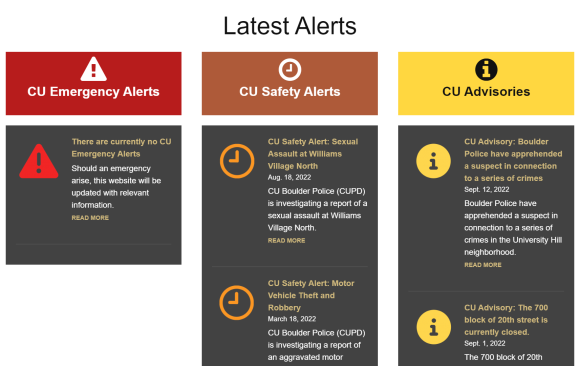
Doreen Jokerst explains the CU Emergency alerts in the YouTube video “CU Alerts: CU Emergency Alerts.” (Courtesy of the University of Colorado Boulder)
The University of Colorado Boulder launched their redesigned CU Boulder Alerts website on Wednesday, Sept. 14. The site now includes more information about alert notification levels and an archive of the recent alerts, as well as other safety and health-related resources. This relaunch is part of the university’s response to complaints raised by the CU Boulder community about the alerts system, following the “shelter in place” CU Alert on Feb. 1 during a partial evacuation of University Hill.
“It’s a university effort to make our emergency information more accessible and more easily understood,” said Christine Mahoney, a spokesperson and public information officer for the CU Boulder Police Department.
CU Alerts is the university’s emergency notification system that delivers information about campus closures, safety concerns and emergencies. Alongside the update to the alerts website, CUPD released a series of safety videos on the emergency alert system, featuring Assistant Vice Chancellor for Public Safety and Chief of Police Doreen Jokerst.
The Jeanne Clery Disclosure of Campus Security Policy and Campus Crime Statistics Act (Clery Act) mandates that federal institutions like CU Boulder notify the campus about emergency events and certain types of crimes. These “Clery Crimes” include criminal homicide, sexual and aggravated assault, domestic violence, hate crimes, robbery, burglary, motor vehicle theft and arrests or referrals related to weapon, drug or alcohol violations.

Latest alerts on the CU Boulder Alerts website (Courtesy of the University of Colorado Boulder)
Here is a breakdown of what each of the alert levels looks like:
CU Emergency Alert
At the highest level, the CU Emergency Alert sends a notification to the CU Boulder community in cases of an ongoing threat to safety on campus or a change to campus operations. This includes active harmers and campus closures or delays due to weather.
“This alert will provide information about the incident, location and personal safety actions you should take,” Jokerst said in the “CU Alerts: CU Emergency Alerts” video.
CU Safety Alert
The next level down is the CU Safety Alert, which sends an email notification when a crime has been committed on or near campus. These notifications also include safety tips and instructions related to the event.
The Clery Act defines “near campus” as areas like sidewalks, streets and parking lots on or “immediately adjacent” to campus.
The alert sent out to the CU Boulder community on Aug. 17 regarding the sexual assault, a Clery Crime, at Williams Village North is an example of a CU Safety Alert. The alert can still be viewed on the CU Boulder Alerts website under the “latest alerts” tab.
CU Advisories
The final level, CU Advisories, is a new addition to the alerts system. This is for non-emergency events on or off campus and for emergency events off campus. CU Boulder may send this alert in an email notification depending on the severity of the event.
Mahoney said that this level was added in an attempt to “better notify the community” about events that impact students, faculty and staff off campus. In addition, the university has advised that the community uses the Everbridge emergency alert system for the city of Boulder.
Two examples of CU Advisory alerts include the arrest of a 17-year-old accused of a series of crimes, including unlawful sexual conduct and burglary, on Sept. 12 this year and the reported gunshots on University Hill on Dec. 6, 2021. These alerts were uploaded to the website, but they not sent in a notification.
“We definitely heard the need for more clear and more timely communication about incidents happening not only on campus but nearby,” Mahoney said.
The CU Boulder community can check the alerts website for updates on all new and previous alerts and for information on how to register for text message alerts.
Contact CU Independent Senior News Editor Bella Hammond at isabella.hammond@colorado.edu.
